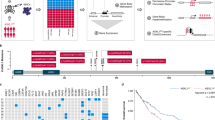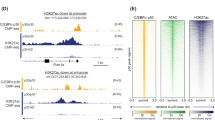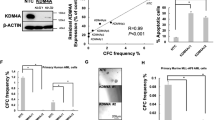Abstract
Somatic inactivating mutations in epigenetic regulators are frequently found in combination in myelodysplastic syndrome (MDS). However, the mechanisms by which combinatory mutations in epigenetic regulators promote the development of MDS remain unknown. Here we performed epigenomic profiling of hematopoietic progenitors in MDS mice hypomorphic for Tet2 following the loss of the polycomb-group gene Ezh2 (Tet2KD/KDEzh2Δ/Δ). Aberrant DNA methylation propagated in a sequential manner from a Tet2-insufficient state to advanced MDS with deletion of Ezh2. Hyper-differentially methylated regions (hyper-DMRs) in Tet2KD/KDEzh2Δ/Δ MDS hematopoietic stem/progenitor cells were largely distinct from those in each single mutant and correlated with transcriptional repression. Although Tet2 hypomorph was responsible for enhancer hypermethylation, the loss of Ezh2 induced hyper-DMRs that were enriched for CpG islands of polycomb targets. Notably, Ezh2 targets largely lost the H3K27me3 mark while acquiring a significantly higher level of DNA methylation than Ezh1 targets that retained the mark. These findings indicate that Ezh2 targets are the major targets of the epigenetic switch in MDS with Ezh2 insufficiency. Our results provide a detailed trail for the epigenetic drift in a well-defined MDS model and demonstrate that the combined dysfunction of epigenetic regulators cooperatively remodels the epigenome in the pathogenesis of MDS.
This is a preview of subscription content, access via your institution
Access options
Subscribe to this journal
Receive 12 print issues and online access
$259.00 per year
only $21.58 per issue
Buy this article
- Purchase on Springer Link
- Instant access to full article PDF
Prices may be subject to local taxes which are calculated during checkout






Similar content being viewed by others
References
Timp W, Feinberg AP . Cancer as a dysregulated epigenome allowing cellular growth advantage at the expense of the host. Nat Rev Cancer 2013; 13: 497–510.
Plass C, Pfister SM, Lindroth AM, Bogatyrova O, Claus R, Lichter P . Mutations in regulators of the epigenome and their connections to global chromatin patterns in cancer. Nat Rev Genet 2013; 14: 765–780.
Oakes CC, Claus R, Gu L, Assenov Y, Hllein J, Zucknick M et al. Evolution of DNA methylation is linked to genetic aberrations in chronic lymphocytic leukemia. Cancer Discov 2014; 4: 348–361.
Ley TJ, Ding L, Walter MJ, McLellan MD, Lemprecht T, Larson DE et al. DNMT3A mutations in acute myeloid leukemia. New Eng J Med 2010; 363: 2424–2433.
Langemeijer SM, Kuiper RP, Berends M, Knops R, Aslanyan MG, Massop M et al. Acquired mutations in TET2 are common in myelodysplastic syndromes. Nat Genet 2009; 41: 838–842.
Shih AH, Abdel-Wahab O, Patel JP, Levine RL . The role of mutations in epigenetic regulators in myeloid malignancies. Nat Rev Cancer 2012; 12: 599–612.
Loiseau C, Ali A, Itzykson R . New therapeutic approaches in myelodysplastic syndromes: hypomethylating agents and lenalidomide. Exp Hematol 2015; 43: 661–672.
Bejar R, Stevenson K, Abdel-Wahab O, Galili N, Nilsson B, Garcia-Manero G et al. Clinical effect of point mutations in myelodysplastic syndromes. New Eng J Med 2011; 364: 2496–2506.
Haferlach T, Nagata Y, Grossmann V, Okuno Y, Bacher U, Nagae G et al. Landscape of genetic lesions in 944 patients with myelodysplastic syndromes. Leukemia 2014; 28: 241–247.
Muto T, Sashida G, Oshima M, Wendt GR, Mochizuki-Kashio M, Nagata Y et al. Concurrent loss of Ezh2 and Tet2 cooperates in the pathogenesis of myelodysplastic disorders. J Exp Med 2013; 210: 2627–2639.
Li Z, Cai X, Cai CL, Wang J, Zhang W, Petersen BE et al. Deletion of Tet2 in mice leads to dysregulated hematopoietic stem cells and subsequent development of myeloid malignancies. Blood 2011; 118: 4509–4518.
Ito S, Shen L, Dai Q, Wu SC, Collins LB, Swenberg JA et al. Tet proteins can convert 5-methylcytosine to 5-formylcytosine and 5-carboxylcytosine. Science 2011; 333: 1300–1303.
He YF, Li BZ, Li Z, Liu P, Wang Y, Tang Q et al. Tet-mediated formation of 5-carboxylcytosine and its excision by TDG in mammalian DNA. Science 2011; 333: 1303–1307.
Jeong M, Goodell MA . New answers to old questions from genome-wide maps of DNA methylation in hematopoietic cells. Exp Hematol 2014; 42: 609–617.
Moran-Crusio K, Reavie L, Shih A, Abdel-Wahab O, Ndiaye-Lobry D, Lobry C et al. Tet2 loss leads to increased hematopoietic stem cell self-renewal and myeloid transformation. Cancer cell 2011; 20: 11–24.
Quivoron C, Couronne L, Valle VD, Lopez CK, Plo I, Wagner-Ballon O et al. TET2 inactivation results in pleiotropic hematopoietic abnormalities in mouse and is a recurrent event during human lymphomagenesis. Cancer cell 2011; 20: 25–38.
Shih AH, Jiang Y, Meydan C, Shank K, Pandey S, Barreyro L et al. Mutational cooperativity linked to combinatorial epigenetic gain of function in acute myeloid leukemia. Cancer cell 2015; 27: 502–515.
Rasmussen KD, Jia G, Johansen JV, Pedersen MT, Rapin N, Bagger FO et al. Loss of TET2 in hematopoietic cells leads to DNA hypermethylation of active enhancers and induction of leukemogenesis. Genes Dev 2015; 29: 910–922.
Oshima M, Iwama A . Epigenetics of hematopoietic stem cell aging and disease. Int J Hematol 2014; 100: 326–334.
Morin RD, Johnson NA, Severson TM, Mungall A, An J, Goya R et al. Somatic mutations altering EZH2 (Tyr641) in follicular and diffuse large B-cell lymphomas of germinal-center origin. Nat Genet 2010; 42: 181–185.
Nikoloski G, Langemeijer SM, Kuiper RP, Knops R, Massop M, Tönnissen ERLTM et al. Somatic mutations of the histone methyltransferase gene EZH2 in myelodysplastic syndromes. Nat Genet 2010; 42: 665–667.
Ernst T, Chase AJ, Score J, Hidalgo-Curtis CE, Bryant C, Jones AV et al. Inactivating mutations of the histone methyltransferase gene EZH2 in myeloid disorders. Nat Genet 2010; 42: 722–726.
Mochizuki-Kashio M, Aoyama K, Sashida G, Oshima M, Tomioka T, Muto T et al. Ezh2 loss in hematopoietic stem cells predisposes mice to develop heterogeneous malignancies in an Ezh1-depenedent manner. Blood 2015; 126: 1172–1183.
Oshima M, Hasegawa N, Mochizuki-Kashio M, Muto T, Miyagi S, Koide S et al. Ezh2 regulates the Lin28/let-7 pathway to restrict activation of fetal gene signature in adult hematopoietic stem cells. Exp Hematol 2016; 44: 282–296.
Lund K, Adams PD, Copland M . EZH2 in normal and malignant hematopoiesis. Leukemia 2014; 28: 44–49.
Sashida G, Harada H, Matsui H, Oshima M, Yui M, Harada Y et al. Ezh2 loss promotes development of myelodysplastic syndrome but attenuates its predisposition to leukaemic transformation. Nat Commun 2014; 5: 4177.
Shide K, Kameda T, Shimoda H, Yamaji T, Abe H, Sekine M et al. TET2 is essential for survival and hematopoietic stem cell homeostasis. Leukemia 2012; 26: 2216–2223.
Astiaso DL, Weiner A, Vivas EL, Zaretsky I, Jaitin DA, David E et al. Chromatin state dynamics during blood formation. Science 2014; 345: 943–949.
Akalin A, Kormaksson M, Li S, Garrett-Bakelman F, Figueroa ME, Melnick A et al. methylKit: a comprehensive R package for the analysis of genome-wide DNA methylation profiles. Genome Biol 2012; 13: R87.
Hon GC, Song CX, Du T, Jin F, Selvaraj S, Lee AY et al. 5mC oxidation by Tet2 modulates enhancer activity and timing of transcriptome reprogramming during differentiation. Mol Cell 2014; 56: 286–297.
Lu F, Liu Y, Jiang L, Yamaguchi S, Zhang Y . Role of Tet proteins in enhancer activity and telomere elongation. Genes Dev 2014; 28: 2103–2119.
Maegawa S, Gough SM, Watanabe-Okochi N, Lu Y, Zhang N, Castoro RJ et al. Age-related epigenetic drift in the pathogenesis of MDS and AML. Genome Res 2014; 24: 580–591.
Beerman I, Bock C, Garrison BS, Smith ZD, Gu H, Meissner A et al. Proliferation-dependent alterations of the DNA methylation landscape underlie hematopoietic stem cell aging. Cell Stem Cell 2013; 12: 413–425.
Klco JM, Spencer DH, Lamprecht TL, Sarkaria SM, Wylie T, Magrini V et al. Genomic impact of transient low-dose decitabine treatment on primary AML cells. Blood 2013; 121: 1633–1643.
Zhao Z, Chen L, Dawlaty MM, Pan F, Weeks O, Zhou Y et al. Combined loss of Tet1 and Tet2 promotes B cell, but not myeloid malignancies, in mice. Cell Rep 2015; 13: 1692–1704.
Pruitt KD, Tatusova T, Maglott DR . NCBI Reference Sequence (RefSeq): a curated non-redundant sequence database of genomes, transcripts and proteins. Nucleic Acids Res 2005; 33: D501–D504.
Ku M, Koche RP, Rheinbay E, Mendenhall EM, Endoh M, Mikkelsen TS et al. Genomewide analysis of PRC1 and PRC2 occupancy identifies two classes of bivalent domains. PLoS Genet 2008; 4: e1000242.
Riising EM, Comet I, Leblanc B, Wu X, Johansen JV, Helin K et al. Gene silencing triggers polycomb repressive complex 2 recruitment to CpG islands genome wide. Mol Cell 2014; 55: 347–360.
Signaroldi E, Laise P, Cristofanon S, Brancaccio A, Reisoli E, Atashpaz S et al. Polycomb dysregulation in gliomagenesis targets a Zfp423-dependent differentiation network. Nat Commun 2016; 7: 10753.
Pellagatti A, Cazzola M, Giagounidis A, Perry J, Malcovati L, Della Porta MG et al. Deregulated gene expression pathways in myelodysplastic syndrome hematopoietic stem cells. Leukemia 2010; 24: 756–764.
Wong YF, Micklem CN, Taguchi M, Itonaga H, Sawayama Y, Imanishi D et al. Longitudinal analysis of DNA methylation in CD34+ hematopoietic progenitors in myelodysplastic syndrome. Stem cells Transl Med 2014; 3: 1188–1198.
Mangelsdorf DJ, Thummel C, Beato M, Herrlich P, Schütz G, Umesono K et al. The nuclear receptor superfamily: the second decade. Cell 1995; 83: 835–839.
Sirin O, Lukov GL, Mao R, Conneely OM, Goodell MA . The orphan nuclear receptor Nurr1 restricts the proliferation of haematopoietic stem cells. Nat Cell Biol 2010; 12: 1213–1219.
Mullican SE, Zhang S, Konopleva M, Ruvolo V, Andreeff M, Mibrandt J et al. Abrogation of nuclear receptors Nr4a3 and Nr4a1 leads to development of acute myeloid leukemia. Nat Med 2007; 13: 730–735.
Ramirez-Herrick AM, Mullican SE, Sheehan AM, Conneely OM . Reduced NR4A gene dosage leads to mixed myelodysplastic/myeloproliferative neoplasms in mice. Blood 2011; 117: 2681–2690.
Kantarjian H, Issa JP, Rosenfeld CS, Bennett JM, Albitar M, Dipesio J et al. Decitabine improves patient outcomes in myelodysplastic syndromes: results of a phase III randomized study. Cancer 2006; 106: 1794–1803.
Jabbour E, Issa JP, Garcia-Manero G, Kantarjian H . Evolution of decitabine development: accomplishments, ongoing investigations, and future strategies. Cancer 2008; 112: 2341–2351.
Zhang Y, Yan X, Chen A, Sashida G, Xiao Z, Huang G . Modeling and targeting MLL-PTD/RUNX1 related MDS/AML in mouse. Blood 2013; 21: 2746.
Wang LX, Mei ZY, Zhou JH, Yao YS, Li YH, Xu YH et al. Low dose decitabine treatment induces CD80 expression in cancer cells and stimulates tumor specific cytotoxic T lymphocyte responses. PLoS One 2013; 8: e62924.
Jaiswal S, Fontanillas P, Flannick J, Manning A, Grauman PV, Mar BG et al. Age-related clonal hematopoiesis associated with adverse outcomes. N Engl J Med 2014; 371: 2488–2498.
Genovese G, Kahler AK, Handsaker RE, Lindberg J, Rose SA, Bakhoum SF et al. Clonal hematopoiesis and blood-cancer risk inferred from blood DNA sequence. N Engl J Med 2014; 371: 2477–2487.
Papaemmanuil E, Gerstung M, Malcovati L, Tauro S, Gundem G, Loo PV et alChronic Myeloid Disorders Working Group of the International Cancer Genome Consortium. Clinical and biological implications of driver mutations in myelodysplastic syndromes. Blood 2013; 122: 3616–3627.
Sun D, Luo M, Jeong M, Rodriguez B, Xia Z, Hannah R et al. Epigenomic profiling of young and aged HSCs reveals concerted changes during aging that reinforce self-renewal. Cell Stem Cell 2014; 14: 673–688.
Issa JP . The myelodysplastic syndrome as a prototypical epigenetic disease. Blood 2013; 121: 3811–3817.
Easwaran H, Johnstone SE, Van Neste L, Ohm J, Mosbruger T, Wang Q et al. A DNA hypermethylation module for the stem/progenitor cell signature of cancer. Genome Res 2012; 22: 837–849.
Bernstein BE, Mikkelsen TS, Xie X, Kamel M, Huebert DJ, Cuff J et al. A bivalent chromatin structure marks key developmental genes in embryonic stem cells. Cell 2006; 125: 315–326.
Oguro H, Yuan J, Ichikawa H, Ikawa T, Yamazaki S, Kawamoto H et al. Poised lineage specification in multipotent hematopoietic stem and progenitor cells by the polycomb protein Bmi1. Cell Stem Cell 2010; 6: 279–286.
Vire E, Brenner C, Deplus R, Blanchon L, Fraga M, Didelot C et al. The polycomb group protein EZH2 directly controls DNA methylation. Nature 2006; 439: 871–874.
Das PP, Hendrix DA, Apostolou E, Buchner AH, Canver MC, Beyaz S et al. PRC2 is required to maintain expression of the maternal Gtl2-Rain-Mirg locus by preventing de novo DNA methylation in mouse embryonic stem cells. Cell Rep 2015; 12: 1456–1470.
Meldi K, Qin T, Buchi F, Droin N, Sotzen J, Micol JB et al. Specific molecular signatures predict decitabine response in chronic myelomonocytic leukemia. J Clin Invest 2015; 125: 1857–1872.
Bejar R, Lord A, Stevenson K, Bar-Natan M, Perez-Ladaga A, Zaneveld J et al. TET2 mutations predict response to hypomethylating agents in myelodysplastic syndrome patients. Blood 2014; 124: 2705–2712.
Khan SN, Jankowska AM, Mahfouz R, Dunbar AJ, Sugimoto Y, Hosono N et al. Multiple mechanisms deregulate EZH2 and histone H3 lysine 27 epigenetic changes in myeloid malignancies. Leukemia 2013; 27: 1301–1309.
Kim E, Ilagan JO, Liang Y, Daubver GM, Lee SC, Ramakrishnan A et al. SRSF2 mutations contribute to myelodysplasia by mutant-specific effects on exon recognition. Cancer Cell 2015; 27: 617–630.
Acknowledgements
We thank Haruhiko Koseki (RIKEN, Japan) for providing us with Ezh2 mutant mice. We thank Sekiya T and Yoshimura T (Keio University, Tokyo) for providing us with the eMIGR1 and eMIGR1-Nr4a vectors. We thank Ola Mohammed Kamel Rizq for the critical review of our manuscript. This work was supported in part by Grants-in-Aid for Scientific Research (#15H02544) and Scientific Research on Innovative Areas ‘Stem Cell Aging and Disease’ (#26115002) from MEXT, Japan, and grants from the Uehara Memorial Foundation, Yasuda Memorial Medical Foundation, and Tokyo Biochemical Research Foundation. The super-computing resource was provided by Human Genome Center, the Institute of Medical Science, the University of Tokyo (http://sc.hgc.jp/shirokane.html).
Author contributions
NH and MO performed the experiments, analyzed results, made the figures and actively wrote the manuscript. GS, HM, SK, MO, AS, CW, TM, KT, AK, CN and KY assisted with the experiments. KS provided mice and AI conceived of and directed the project, secured funding and actively wrote the manuscript.
Author information
Authors and Affiliations
Corresponding author
Ethics declarations
Competing interests
The authors declare no conflict of interest.
Additional information
Supplementary Information accompanies this paper on the Leukemia website
Supplementary information
Rights and permissions
About this article
Cite this article
Hasegawa, N., Oshima, M., Sashida, G. et al. Impact of combinatorial dysfunctions of Tet2 and Ezh2 on the epigenome in the pathogenesis of myelodysplastic syndrome. Leukemia 31, 861–871 (2017). https://doi.org/10.1038/leu.2016.268
Received:
Revised:
Accepted:
Published:
Issue Date:
DOI: https://doi.org/10.1038/leu.2016.268
This article is cited by
-
Immunohistochemical loss of enhancer of Zeste Homolog 2 (EZH2) protein expression correlates with EZH2 alterations and portends a worse outcome in myelodysplastic syndromes
Modern Pathology (2022)
-
Overexpression of Hmga2 activates Igf2bp2 and remodels transcriptional program of Tet2-deficient stem cells in myeloid transformation
Oncogene (2021)
-
Dysregulation of 2-oxoglutarate-dependent dioxygenases by hyperglycaemia: does this link diabetes and vascular disease?
Clinical Epigenetics (2020)
-
The functional mechanisms of mutations in myelodysplastic syndrome
Leukemia (2019)
-
Deregulated Polycomb functions in myeloproliferative neoplasms
International Journal of Hematology (2019)



